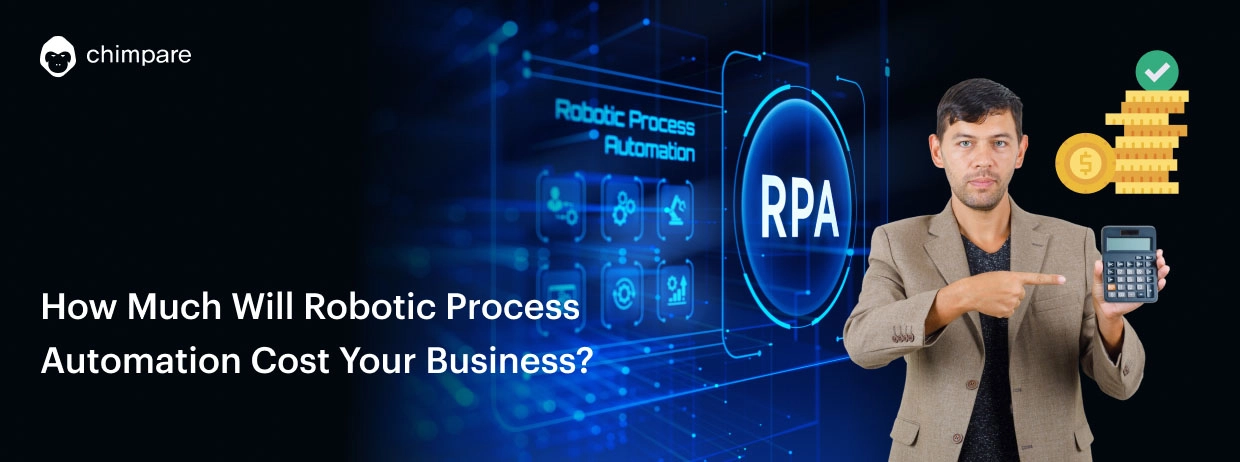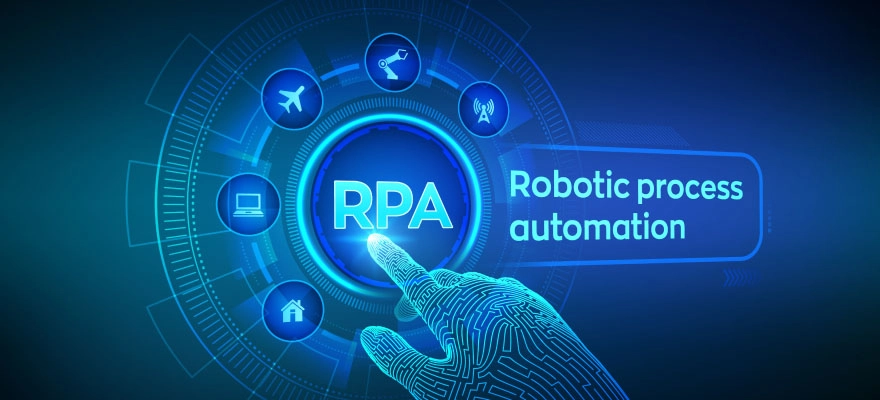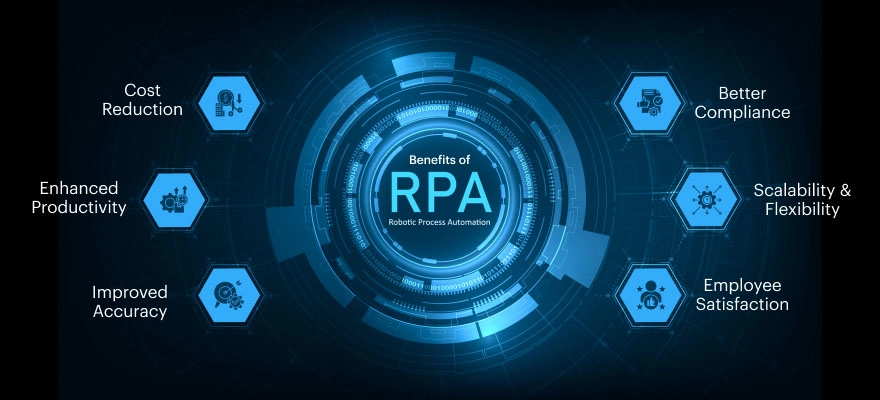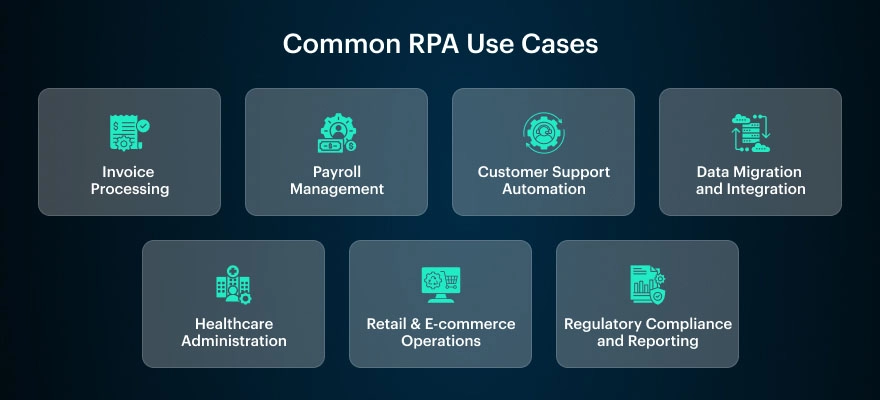How Much Will Robotic Process Automation Cost Your Business?

Table of Contents
In the digital economy, companies are racing to streamline their approaches and provide better customer service. Robotic Process Automation Cost has become a buzzword in industries starting from banking and healthcare to retail, and beyond.
Companies are deploying RPA to handle tasks such as record entry, invoice approvals, and compliance tracking, which can be completed by entire teams on workdays.
Industrial surveys now show that more than half of organisations use RPAs, and the industry is predicted to exceed $6.8 billion by 2026, showing how widespread this technique has become.
This pass no longer simply improves accuracy and compliance; it also reduces costs, with some companies reporting operational financial savings of as much as 50% after enforcing automation.
For organisations building out custom software solutions, RPA has quickly moved from a “nice-to-have” to an “essential” tool in the digital toolkit, often integrated into broader custom software application development projects to create seamless workflows tailored to unique business needs.
The push toward digital transformation is accelerating, and you’ll notice agile software development teams working closely with RPA as part of broader automation strategies. It’s not only about installing a tool; it’s about comprehending frameworks, whether it’s “what is a software framework for AI?” or a process framework in software engineering.
What is Robotic Process Automation?

Robotic system automation technologies use software program robots, or “bots,” to automate repetitive, rule-based operations that people could commonly execute. These bots interact with packages and structures in the same way that human beings do, however, quicker and with greater accuracy. RPA is widely utilised across sectors to reinforce productivity, minimise mistakes, and free up human resources for valuable tasks.
In the banking area, RPA bots can take care of obligations which includes processing loan applications, updating purchaser statistics, and dealing with compliance reviews. Automation is not the simplest expedient for these tactics, but it additionally ensures consistency and decreases the probability of human error.
RPA is utilised inside the healthcare sector to automate affected person records access, appointment scheduling, and billing processes, leading to better productivity and better patient care. The quick boom of the worldwide RPA marketplace is a sign of the developing adoption of this technology across many sectors.
What are the Benefits of Robotic Process Automation?
Robot process automation has significant benefits for companies in a series of automation industries. Here are some benefits:

1. Cost Reduction
RPA adoption can bring about fantastic price savings through automating repetitive processes, doing away with the need for manual labour, and stopping mistakes.
2. Enhanced Productivity
RPA bots can run constantly, resulting in prolonged throughput and quicker project final touch. This non-stop operation lets personnel focus on greater strategic duties; for this reason, it improves typical productivity.
3. Improved Accuracy
RPA reduces the chance of errors through doing away with human involvement in record get admission to and processing, leading to improved accuracy in sports activities, collectively with bill processing and fact reconciliation.
4. Better Compliance
RPA will increase compliance and decrease the risk of noncompliance consequences via preserving strategies contemporary and consistent with regulatory requirements.
5. Scalability and Flexibility
Because RPA frameworks are without problems adaptable to deal with expanding workloads, firms may respond to changing demands without incurring additional costs.
6. Employee Satisfaction
Routine mission automation allows groups of workers to consciousness on extra complicated and superior tasks, increasing undertaking satisfaction and decreasing turnover.
RPA promotes customer happiness and operational performance in the retail sector by enabling stock management, order processing, and customer support. RPA is a valuable funding source for agencies trying to gain a competitive advantage because it allows them to streamline processes, lower costs, and improve provider transport.
What are the Common RPA Use Cases?
Robotic Process Automation is being extensively followed across industries as it enables reducing operational charges, improving accuracy, and freeing personnel from repetitive responsibilities. Here are some of the most unusual and trending use cases:

1. Invoice Processing
Companies frequently spend hours entering and confirming invoices. RPA bots may also accumulate facts from invoices, verify them, and replace economic systems automatically. This lowers errors and accelerates processing. Deloitte estimates automation can cut invoice handling costs by up to 60%.
2. Payroll Management
HR departments in large organisations rely on RPA platforms to handle payroll, tax calculations, and compliance reporting. This not only reduces RPA cost by saving manual effort but also ensures accurate and timely salary disbursements.
3. Customer Support Automation
Businesses utilise RPA tools in conjunction with chatbots to handle routine customer enquiries like order tracking or account changes. For example, telecom businesses use RPA systems to handle thousands of support enquiries every day without recruiting more workers.
4. Data Migration and Integration
Many businesses still use old systems. RPA software program permits information to be transferred between old and new systems at the same time as retaining normal operations. This is especially genuine in banking and insurance, where regulatory compliance calls for secure information management.
5. Healthcare Administration
Hospitals use RPA to automate patient appointment scheduling, claims processing, and scientific billing. According to a recent poll, more than 30% of healthcare specialists in the United States are already adopting RPA software to save time and improve patient care performance.
6. Retail and E-commerce Operations
From inventory updates to reserve confirmations, RPA companies use automation to streamline delivery chain methods. Retailers, for example, utilise RPA bots to screen inventory levels in real time, which reduces waits and increases customer satisfaction.
7. Regulatory Compliance and Reporting
RPA developers in industries such as banking and finance set bots to create compliance reports and song transactions, decreasing the chance of human mistakes and making sure tight industry standards are met.
In a nutshell, RPA corporations use intelligent automation to assist organisations in a whole lot of industries to save cash, enhance efficiency, and grow operations. Businesses that make investments in the right RPA solutions can decrease manual work, save money, and gain faster turnaround times whilst preserving remarkable effects.
Unlock RPA Potential for Your Business Today
From roadmap to execution, we’ll help you implement AI that drives measurable growth.
What are the Key Factors Affecting RPA Costs?
The cost of robotic process automation is not fixed; it is determined by the company’s requirements, process complexity, and RPA platform selection. Here are the primary elements influencing RPA pricing:
1. Process Complexity
Automating simple, rule-based operations is frequently less expensive. However, when workflows include decision-making, several apps, or unstructured data, the RPA developer’s labour and cost rise dramatically. For example, automating payroll is cheaper than building an RPA bot for fraud detection in banking.
2. Number of Bots Deployed
The greater the number of RPA bots an organisation wishes, the better the preliminary investment. A small business might also begin with one or both, at the same time as establishments frequently scale to loads, leading to a higher universal RPA price but extra long-term savings.
3. Licensing and Platform Fees
Different RPA tools and vendors have varied pricing models. Some charge per bot, while others use subscription-based models. A Gartner report revealed that licensing can account for nearly 25–30% of total RPA software expenditure.
4. Implementation and Development Effort
The knowledge required to design, test, and implement automation has an impact on costs. Hiring in-house employees in preference to be outsourcing to RPA companies or robotic process automation services can significantly affect the prices.
5. Maintenance and Support
Once created, RPA systems require ongoing improvement, monitoring, and expansion. This continued assistance raises the total ownership cost. Many companies underestimate this element; however, disregarding it could lead to poorer output and elevated downtime.
6. Integration with Existing Systems
Once carried out, RPA technologies require ongoing improvements, tracking, and boom. This continuing assistance increases the total ownership cost. Many establishments underestimate this detail but disregarding it may lead to reduced productivity and greater downtime.
7. Compliance and Security Requirements
Banking, healthcare, and insurance are just a of the industries with multiplied compliance obligations. Building stable RPA solutions that observe policies may raise development and preservation costs, even as avoiding hefty consequences later.
In short, the price of robot procedure automation is decided with the aid of a selection of factors, which include bot complexity and licensing charges. Before choosing an RPA organisation or platform, organisations need to cautiously take into account these elements with the intention of deciding the exact price and ROI of automation.
Smarter Decisions. Faster Outcomes.
Leverage expert RPA consulting to cut costs, boost efficiency, and stay ahead of competitors.
What are RPA Implementation Costs?
The value of robotic process automation consists of prices for development, deployment, and ongoing support, as well as software licensing. Businesses ought to consider the subsequent RPA installation prices before investing:
1. Licensing Fees for RPA Tools
Most RPA platforms charge annual or per-bot licenses. According to Deloitte, licensing can make up nearly 30% of the total RPA cost. For example, automating five finance processes with UiPath may cost significantly more than a single process deployment due to multiple bot licenses.
2. Infrastructure and Hosting Costs
Companies need to decide between on-premises and cloud implementations. While on-premises RPA necessitates server funding, cloud-primarily based RPA solutions offer scalability and routine subscription prices, making them especially cost-effective for startups.
3. Development and Customisation
Engaging an RPA developer or outsourcing to robotic method automation companies adds to the budget. An easy statistics-access automation would possibly take 2-3 weeks to construct; however, complex workflows like coverage declaration processing may additionally need months of customisation.
4. Training and Change Management
Before deployment, each RPA bot must be examined to verify accuracy and prevent procedure disturbances. Many RPA companies now include training packages in their RPA solutions to speed up digital transformation.
5. Testing and Quality Assurance
Before deployment, each RPA bot must be tested to verify accuracy and prevent process disturbances. Automation errors can pose a compliance concern, particularly in areas such as banking and healthcare. Testing increases the initial RPA software price but eliminates costly mistakes later.
6. Maintenance and Support
Once live, bots require monitoring, updates, and scaling. Gartner reports that ongoing support may account for 20–25% of total RPA cost annually. Without regular updates, even satisfactory RPA equipment loses performance.
In short, the real cost of robotic process automation extends past the purchase of RPA software. Businesses must budget for charges, together with licensing and upkeep, to maximise ROI and ensure long-term automation.
What are Ongoing Costs and Maintenance of Robotic Process Automation?
The robotic process automation fee isn’t limited to software licensing; it’s also charged for improvement, deployment, and ongoing aid. Businesses ought to consider those RPA implementation fees earlier than investing:
1. Licensing Fees for RPA Tools
Most RPA platforms charge annual or per-bot licenses. According to Deloitte, licensing can make up nearly 30% of the total RPA cost. For example, automating five finance processes with UiPath may cost significantly more than a single process deployment due to multiple bot licenses.
2. Infrastructure and Hosting Costs
Companies want to decide between on-premises and cloud deployment. While on-premises calls for server investment, cloud-based RPA services provide scalability with predictable subscription models, making them more price-efficient for startups.
3. Development and Customisation
Engaging an RPA developer or outsourcing to robotic method automation companies provides a cost-effective solution to the budget. A simple statistics-access automation would possibly take 2–3 weeks to construct; however, complicated workflows like coverage declaration processing may also need months of customisation.
4. Training and Change Management
Employees need training to work alongside RPA bots. Investing in skill-building ensures smooth adoption and reduces resistance. Many RPA companies now include training packages in their RPA solutions to speed up digital transformation.
5. Testing and Quality Assurance
Before deployment, every RPA bot ought to be tested to ensure accuracy and save you from device interruptions. Errors in automation can bring about compliance dangers, in industries like banking or healthcare. Testing adds to the preliminary RPA software program costs but prevents expensive mistakes later.
6. Maintenance and Support
Once live, bots require monitoring, updates, and scaling. Gartner reports that ongoing support may account for 20–25% of total RPA cost annually. Without regular updates, even the best RPA tools lose efficiency.
The real robotic process automation cost is going beyond purchasing RPA software. From licensing to renovation, groups need to plan for those charges to maximise ROI and ensure sustainable automation.
How to Reduce the RPA Implementation Costs?
While the preliminary price of robot technique automation may additionally seem excessive, there are tried-and-true methods for helping enterprises manage fees and obtain a faster ROI. Here are a few realistic techniques for reducing RPA deployment prices while keeping the best:
1. Start Small, Then Scale
Begin with one or two strategies that deliver quick wins, like bill processing or payroll. PwC reports that businesses adopting this “pilot-first” approach reduce initial RPA cost by nearly 25%.
2. Use Cloud-Based RPA Platforms
Instead of making a heavy investment in on-premises servers, many corporations are turning to cloud-hosted RPA systems. These offer pricing mechanisms, making them ideal for SMEs seeking low-cost access to strong RPA equipment.
3. Leverage Pre-Built RPA Bots
Leading RPA organisations like UiPath and Automation Anywhere offer libraries of pre-made bots. Adopting those in place of constructing from scratch can save weeks of development time and lower fees.
4. Outsource to Experienced RPA Developers
Partnering with a robotic-managed automation firm or an RPA service provider can often prevent cash over hiring full-time personnel. Experienced RPA builders ensure quicker deployment and less disasters, at the same time as preserving long-term RPA costs under control.
5. Automate Wisely with ROI in Mind
Not each method is well worth automating. Businesses should emphasise workflows which are massive in quantity, repeatable, and rule based.
6. Continuous Monitoring and Optimisation
Regularly reviewing the performance of each RPA bot guarantees maximum performance. Gartner notes that agencies that actively screen automation see 30% higher ROI as compared to people who “set and overlook.”
By using these strategies, businesses can increase the sustainability and value-effectiveness of automation while balancing the long-term financial benefits of RPA software programs.
What is the Total Cost Vs. ROI of RPA?
When calculating the value of robotic process automation (RPA), businesses often compare the implementation cost against the return on investment (ROI).
Cost Factors (RPA Investment) | ROI & Business Benefits | Example / Real Case |
RPA Software & Platform Costs | Saves up to 30–50% in operational costs by replacing repetitive manual work. | A bank using an RPA bot for customer KYC reduced onboarding time from 40 minutes to 10 minutes. |
RPA Developer & Setup Costs | Faster automation rollout, reducing error rates by up to 90%. | An insurance company partnered with robotic process automation companies to automate claim processing, cutting manual errors drastically. |
Infrastructure & Maintenance | Scalability – once deployed, the same RPA service can handle 24/7 operations with minimal downtime. | Retailers use RPA solutions during seasonal sales to manage surges in transactions without hiring extra staff. |
Training & Change Management | Employee productivity improves as they focus on high-value tasks instead of repetitive work. | A healthcare provider automated appointment scheduling with an RPA platform, freeing staff for patient care. |
Ongoing Support from RPA Companies | Long-term ROI grows 2–4x as processes get optimised over time. | Manufacturing firms using RPA software for the supply chain gained faster delivery cycles and reduced overhead costs. |
Your AI Transformation Starts Here
Get a custom plan built around your business goals – without the tech overwhelm.
What are the RPA Pricing Examples?
The value of robot technique automation varies substantially depending on the scale of the venture, the complexity of the methods being automated, and the RPA platform or RPA tools hired. To assist you in understanding, below are some practical RPA pricing examples that reflect healthy modern market trends:
1. Small-Scale Automation
- Cost: The value of one RPA bot consistent with the year is between $5,000 and $15,000, depending on the RPA software license used.
- Use Case: An economic team automates bill statistics entry, saving masses of hours per 12 months. Even with this little investment, the ROI is expected within 6-9 months.
2. Mid-Level Automation
- Cost: Approximately $30,000 to $90,000 per year, which incorporates the license, hiring an RPA developer, and infrastructure.
- Use Case: An HR department uses the RPA generation to automate worker onboarding, payroll adjustments, and compliance reporting. Many RPA vendors indicate that with this configuration, mid-sized enterprises can save 25-40% on operating costs.
3. Enterprise-Grade RPA Solutions
- Cost: From $100,000 to $500,000+ per year, including several bots, enterprise-level robotic process automation software, cloud hosting, and continuing RPA service from experienced robotic process automation providers.
- Use Case: A big bank automated fraud detection and compliance checks across all of its branches using enterprise-level RPA technology. Processing times were shortened by 40% as a result, saving millions of dollars in operating costs.
4. RPA as a Service (Subscription Model)
- Cost: Depending on intricacy, the cost per process/month is between $1,000 and $5,000.
- Use Case: Startups and SMEs often prefer this model, as it avoids upfront investment in infrastructure. For example, a retail SME adopted subscription-based RPA services to handle customer refunds during peak shopping seasons, improving customer satisfaction while keeping RPA costs predictable.
5. Custom RPA Development Projects
- Cost: The average cost of a project ranges from $20,000 to $150,000, depending on the complexity of the automation and whether it requires interface with legacy systems.
- Use Case: A logistics company worked with RPA providers to develop specialist bots for supply chain tracking. The investment paid off in less than a year by minimising cargo delays and improving delivery routes.
Conclusion
The robotic process automation cost may additionally appear like a full-size investment in the beginning, but its long-term benefits far outweigh the initial costs. Businesses that implement RPA usually experience ROIs of 30–200% since it saves labour hours, speeds up project execution, and yields error-free outcomes.
Businesses may save operating costs, optimise workflows, and free up staff members for more lucrative work by utilising expert RPA builders and the right RPA technology.
With extra robot system automation businesses now offering flexible, cloud-based RPA offerings, adoption has become less complicated and costly for corporations of all sizes.
While the RPA cost depends on elements which include scale, complexity, and the desire for an RPA platform, the efficiency, scalability, and accuracy it promises make it one of the most strategic technology investments these days. Simply put, RPA isn’t always just about automation; it’s about unlocking boom and staying aggressive in an unexpectedly evolving virtual world.
FAQs
The complexity of the procedures being automatic, the range of RPA bots needed, the platform or tools selected, the interaction with present-day systems, and whether you work with robot method automation organisations or hire RPA engineers internally are some of the variables that affect RPA costs.
For big companies, RPA software license, deployment, and ongoing upkeep fees regularly range from $100,000 to $500,000. Costs may additionally vary depending on scale, the wide variety of automated approaches, and the form of RPA offerings used.
The quantity of workflows to automate, undertaking complexity, RPA platform licensing fees, development or outsourcing costs, and continuing renovation are all crucial concerns while estimating RPA costs. Numerous robotic method automation companies provide consulting offerings to help in determining the suitable return on funding and universal implementation charges.

Samuel Meleder
Samuel Meleder founded Chimpare, a global company that builds software solutions. With a passion for innovation and a commitment to helping businesses grow through smart digital strategies, Samuel leads a global team delivering cutting-edge solutions across industries
Found this post insightful? Don’t forget to share it with your network!
Related Articles

Why is Everyone Investing in E-Commerce Website Development?
It is an idea that e-commerce is “just another digital trend”, but online shopping has really changed a lot in

What Will Key Trends of Generative AI Look Like in 2026?
Generative AI is no longer a futuristic idea; it’s already reshaping the way we build software, create content, and solve real-world problems.

How Is AI in Web Technology Redefining the Future of the Web?
AI is the main tool of contemporary online interactions, which has been transformed in a way that is much faster
